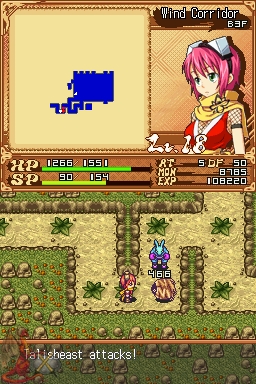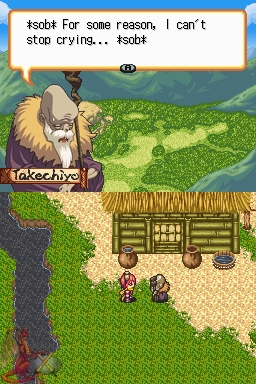|
|

|
PLATFORM
|
DS
|
BATTLE SYSTEM
|

|
INTERACTION
|

|
ORIGINALITY
|

|
STORY
|

|
MUSIC & SOUND
|

|
VISUALS
|

|
CHALLENGE
|
Moderate
|
COMPLETION TIME
|
20-40 Hours
|
|
OVERALL

|
+ Good for short play sessions
+ Excellent controls
+ Represents a rare genre outside of a PC
- Luck is too large of a factor
- Level grinding is a must
- Story is more irritating than cute
|
Click here for scoring definitions
|
|
|
In a land where everyone is happy, the world is at peace, and the gods watch over the humans, a band of unemployed ninjas strolls into a backwater village and promptly ruins everything. More specifically, the pink haired Izuna ruins everything by stealing the first shiny object she lays eyes upon, thereby angering the gods and causing them to curse the entire village out of shallow spite. The player controls Izuna, titular character of Izuna: Legend of the Unemployed Ninja, who must convince the gods to remove their curses by slogging through shape shifting dungeons and beating the snot out of the god living at the bottom of each one.
Izuna’s quest is a Roguelike affair. Each dungeon consists of a set number of randomly generated floors with enemies and items scattered around. The dungeons are reset and regenerated every time one is entered. Gameplay is turn based; the monsters only move or attack after Izuna completes an action. The only way to leave a dungeon aside from dying or defeating the boss is to use an uncommon escape talisman. There is one save file, the game automatically saves between floors, and powering off the DS without formally saving is treated the same as dying. This game differs from the genre’s standards in that character death is not permanent, all items are identified, and the unnecessary plot is terrible.
Gameplay starts out simply. Enter the dungeon. Play until death inevitably occurs. Lose everything but your experience points and get booted back to the village. Repeat. At the beginning only the most basic of items spawn in the dungeon, but as the game progresses and more dungeons open up, items become more complicated and enemies become more devious. Each time Izuna provides you with a new way to stomp monsters down, the enemies and even the dungeons themselves gain new ways to humble and break you. The massive piles of death heaped upon the player are so varied and heartless that it would almost be a spoiler to list the details here. The developers want you to be traumatized. New tortures are gradually introduced with a well paced learning curve and minimal in game help regarding new items. The assumption is that players will experiment to figure out how best to use each talisman.
Talismans are Izuna’s catch all for spells and weapon upgrades. They are plentifully spread all over each floor with the clear indication that they are to be used as needed instead of hoarded in Izuna’s limited inventory. A talisman’s effects can change slightly based on whether it is used, stuck to a weapon, or chucked at a monster. Finding these powerful spells everywhere would make the game easy if one just ran around, blasting every baddie in sight, so there is a system in place to punish you for using talismans in the form of SP. SP is a cruel combination of stamina and magic points. When an enemy smacks Izuna, SP is lost. When Izuna uses a talisman, SP is significantly lost. Izuna’s remaining SP has a major impact on how much damage she deals to enemies and keeping it maxed is nearly a requisite for not dying. This hinders talisman use if there are no SP restoratives available.
 I won’t spoil what talisbeasts do, but it is horrible
I won’t spoil what talisbeasts do, but it is horrible
|
|
As the game moves on and the village slowly comes back to life, various shops open to assist Izuna when her task becomes more daunting. A storehouse becomes available to hold excess items and safely bank money, a blacksmith comes to repair weapons so they do not shatter to pieces as often, and a talisman shop opens to provide the player with easy access to the most utilitarian and necessary talismans. The escape talisman then becomes readily available, and it can be stuck to a weapon to teleport it to the storehouse in the event of a game over. All this aid is required as the dungeons become deeper and tougher.
The deepest and toughest dungeons are where the gameplay suffers. Izuna’s inventory is so small that no matter how carefully one manages item use, there is always a heavy reliance on needing crucial items to appear on the randomly generated ground. About a fourth of the way into the game, invisible traps with potentially game over inducing effects appear in large quantities on every floor. These traps can also destroy talismans in the inventory. The first time an invisible trap burns away the ability to escape and Izuna’s upgraded weapon is lost forever will be a memorable one. Or not. When Izuna dies, her character level stays intact, and this largely ruins the strategic side of the game. The issue here is that Izuna’s level determines her HP, SP, and the amount of damage she deals. Ultimately, strategy and skill alone are not enough to conquer a new dungeon the first time through; one must try and retry, level grinding to obtain stats high enough for the dungeon to be completed. Also, as frustrating as losing a powerful weapon can be, it feels even worse realizing that Izuna’s barehanded slap deals nearly the same damage as the souped up uber-sword you just lost.
This leads to general apathy toward dying. The point of playing shifts from the standard “do not get a game over” to “gain as much experience as possible”. Whether you lose, or escape, and whether you save your not-so-amazing weapons, or not: it is all trivial when character level and the luck of finding items have an overpowering effect on performance. Sure, there will be critical moments where it takes wits to survive, but losing carries such a slight penalty that successfully struggling to last just a bit longer often delivers no tangible rewards.
 This happens when you first attempt the final dungeon
This happens when you first attempt the final dungeon
|
|
While cheap deaths via enemies and traps are commonplace, the precise control setup leaves the blame for Izuna’s screams of agony directly in the player’s hands. All of the buttons on the DS are well utilized to make navigating the menus and dungeons a snap. The top screen displays an automap and Izuna’s stats. Visually, the menus and map are clear and readable. The character and monster sprites are also easily identifiable. They lack the charm of a Dragon Quest or Pokemon game, but they are discernable on the screen at a quick glance; functionally, this is important for a dungeon crawler even though the developers did not go the extra mile to give the baddies some personality. The translation part of the game’s interaction is less solid. All talismans and some enemies have names in Japanese or gibberish. It is possible that the talismans all have meaningful titles, but those not fluent in Japanese will need to memorize strange spellings or look up a talisman’s effects in the menu each time one is obtained.
Translation disappointments also affect the story. Dungeon crawlers as a genre tend to have a deficient or threadbare plot. The wizards at Atlus USA, who normally excel at localization, crafted an in your face story around an obnoxious, completely unlikeable and irritating girl who routinely cries and threatens to kill herself. The extremely Japanese setting has characters who awkwardly speak in American English colloquialisms. They are supposed to be cute or entertaining, but are annoying instead. The gaming experience would be much improved had everyone in the village been born mute. The music and sound effects are forgettable and obviously little time or care was spent creating them. The background score feels absent, and were it not for the fact that sound effects are potentially helpful while laboring through the dungeons, this game could be played with the volume off and nothing would be missed.
Izuna: Legend of the Unemployed Ninja is a flawed Roguelike. Were the storyline removed and the effect of character level on the player's abilities lessened, the game would be significantly more enjoyable. The emphasis on level grinding over strategy and avoiding death exposes a desire to appeal to new, younger fans. The result, though, is an experience that is less fun rather than less difficult. All things considered, Izuna is not a total wash. The ability to save often makes it ideal for short play sessions; the arduous and unfulfilling gameplay is genuinely pleasurable in 15 minute bursts, especially in the beginning and middle of the game before the dungeons become overly brutal. Any fan of the genre should definitely pick this up as there are so few Roguelikes outside of the PC world. As long as expectations are tempered, there is feasibly enough fun here to warrant a purchase, but most gamers should pass this one by.
Review Archives
|









